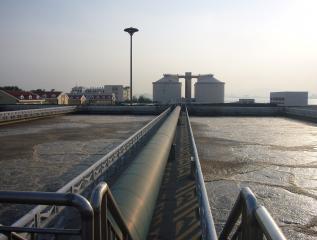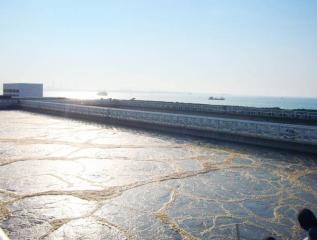 Optimization of aeration systems
Optimization of aeration systems
Aeration systems are the main power consumers in biological wastewater treatment facilities. In the course of this project, these systems were optimized in terms of power consumption for use in hot and cold climates. One of the major aims was to arrive at a computation approach that would be more detailed than the currently-applicable design rules (e.g. DWA Technical Recommendations 229) for calculating the necessary oxygen input with due regard to water temperature.
Relevant parameter
To arrive at this extended design approach, it was above all necessary to examine interface factor a (oxygen mass transfer coefficient ratio for wastewater and purified water) as a function of water temperature with due regard to typical wastewater parameters.
Experimental facilities and execution of the trials
Practical tests were carried out in experimental facilities linked to industrial-scale plants. To this end, three test columns accommodated in a container have been positioned next to aeration tanks and real wastewater was fed into them parallel to the basin. The test columns thus simulated segments of the industrial-scale plants.
 Sites and project partners in China
Sites and project partners in China
The practical tests were carried out one after the other, in collaboration with Tongji University Shanghai and Qingdao Technological University, in two local sewage treatment plants in China.
Operating sequences:
- Determination of the α value (interface factor) as a function of wastewater temperature and other parameters having an impact on the α value, e.g. surface-active agents.
- Examination of α-value variability as a function of time (hourly, daily, weekly). This was designed to verify the impact of fluctuating inlet loads on oxygen input as a function of water temperature.
- Determination of the oxygen consumption rate as a function of wastewater temperature, as the necessary oxygen input during operation is also affected by the microbial oxygen consumption.
- Examination of the interrelations between the wastewater temperature and aeration intensity parameters and the sludge settling properties. The aim was to examine the impact of water temperature on the settling properties of the sludge in order to minimize the percentage of solids in the effluent.
- Validation of interdependencies already established between the a value and the organic dry substance content or the activated sludge’s hydrostatic flock volume.
Project partners:
Technische Universität Darmstadt, Institut IWAR, Fachgebiet Abwassertechnik
Franziska-Braun-Str. 7, 64287 Darmstadt
www.iwar.bauing.tu-darmstadt.de
Persons to contact:
Prof. Dr.-Ing. Martin Wagner, m.wagner@iwar.tu-darmstadt.de
M.Sc. Stephan Sander, s.sander@iwar.tu-darmstadt.de
Aqseptence Group GmbH (bis 2016: Bilfinger Water Technologies GmbH)
Passavant-Geiger-Straße 1, 65326 Aarbergen
www.water.bilfinger.com
Persons to contact:
Dr.-Ing. Jiansan Zhang, jiansan.zhang@bilfinger.com





